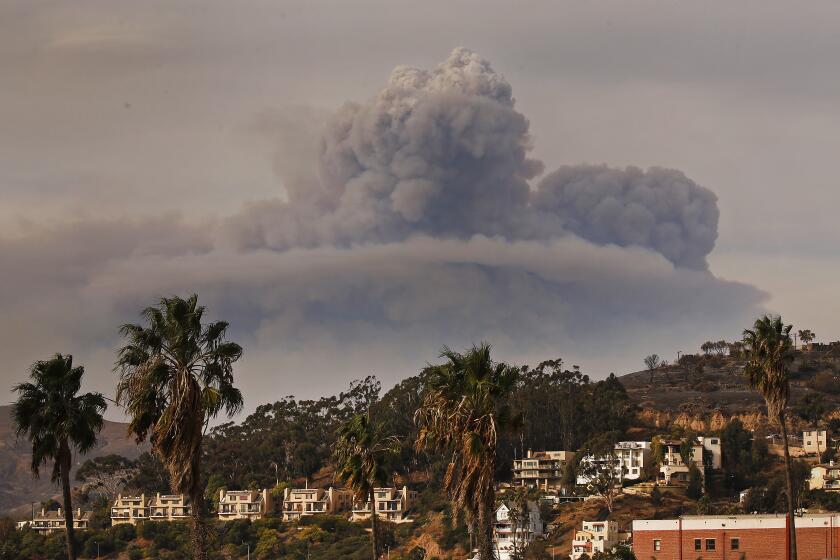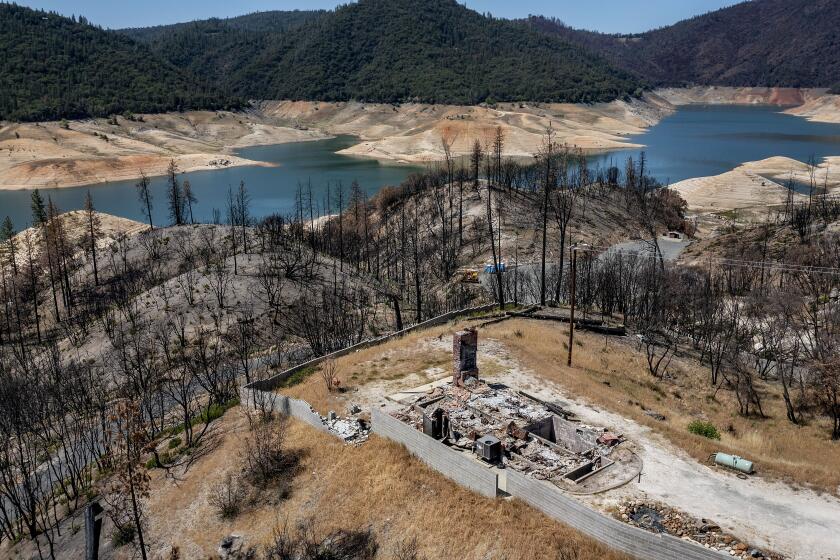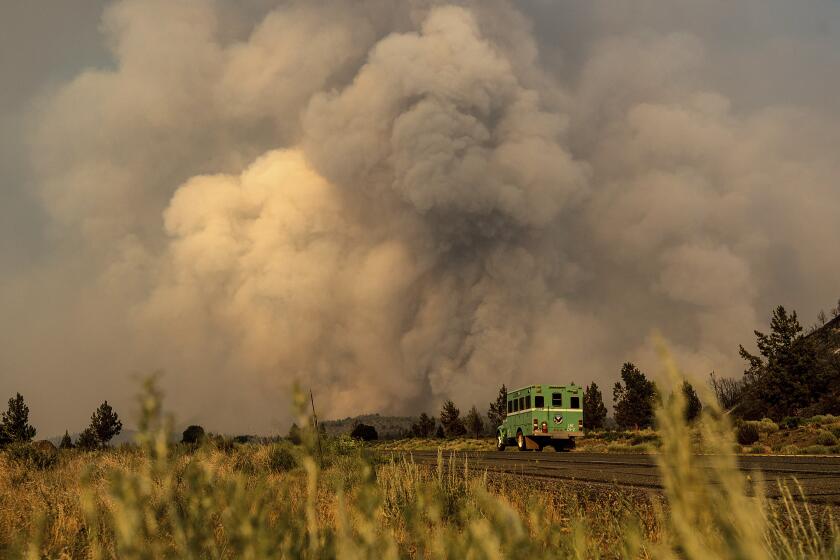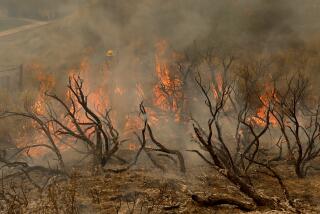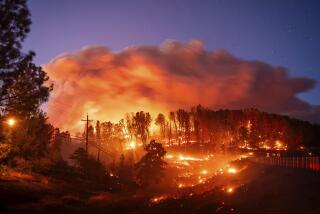California wildfire generates its own lightning as it more than doubles in size
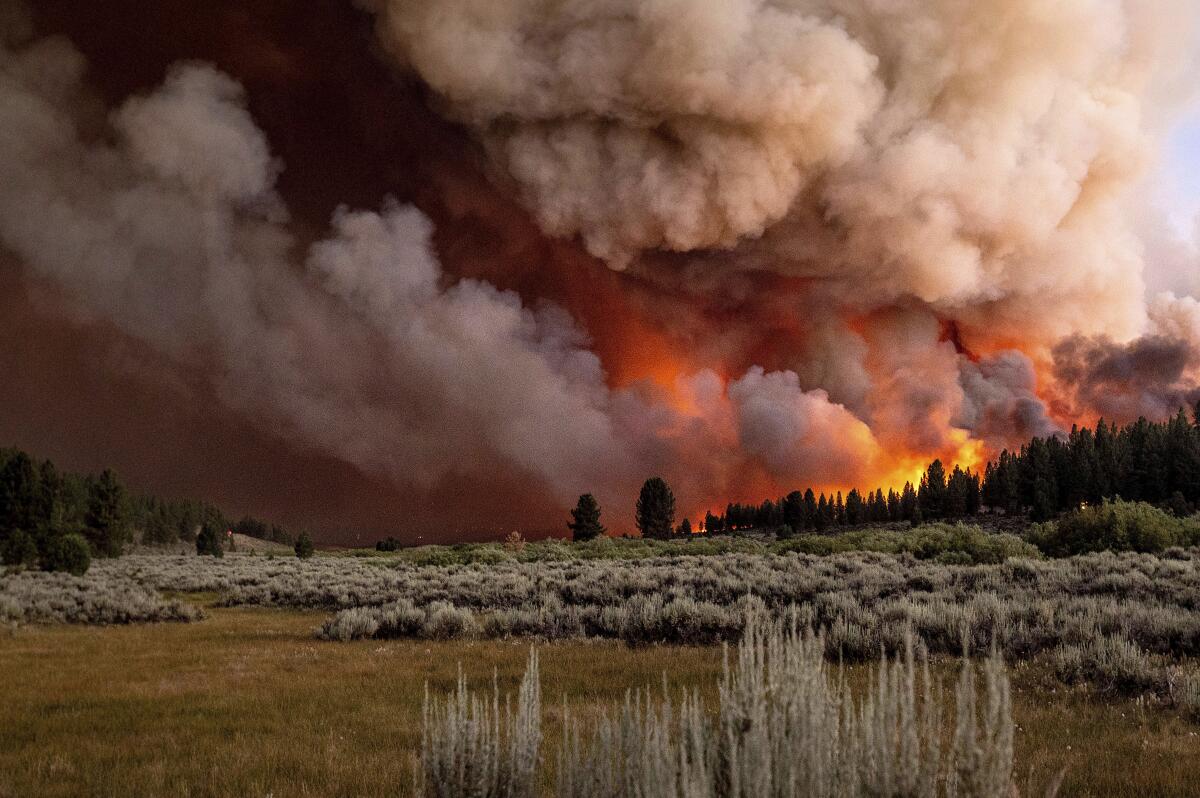
- Share via
A wildfire in Northern California more than doubled in size from Friday to Saturday, sending up a massive cloud of smoke and ash that, combined with the dry heat, generated its own lightning and created dangerous weather conditions for firefighters, authorities said.
The Sugar fire, which ignited July 2, had spread to 54,421 acres and was 8% contained as of Saturday morning. The fire, now the state’s largest of the season, was one of two sparked by lightning in the Plumas National Forest that have together been dubbed the Beckwourth Complex fires. The other, the Dotta fire, started June 30 and was 670 acres and 80% contained by early Saturday.
Fueled by a midweek heat wave that exacerbated already hot, dry conditions, the Sugar fire made a huge run Friday, triggering new evacuations for portions of Plumas and Lassen counties, as well as part of Washoe County, Nev. The Washoe County evacuations were lifted Saturday but residents were advised to stay vigilant. About 2,800 people remained under evacuation orders or warnings, officials said.
Firefighters were bracing for another day of extreme conditions amid even hotter temperatures.
“As long as it’s this hot and we have these low humidities, it’s kind of hard to tell when and where we’re going to catch this,” said Lisa Cox, information officer for the Beckwourth Complex fires.
Fire crews were seeing flare-ups in groups of trees and spot fires ignited by far-flung embers as flames tore through timber stands, she said.
“That increases the velocity of the spread of the fire because the fire’s actually moving amongst the treetops,” she said. “Basically, it just runs across the trees until it runs out of trees.”
Such intensity, combined with hot, dry, unstable conditions, can generate a thunderstorm cloud, as the fire did Friday afternoon, when the incident meteorologist observed cloud-to-cloud lightning, Cox said.
So-called pyrocumulonimbus clouds can, in turn, make the fire spread even faster — in addition to lightning, they can create erratic, ember-spitting winds.
“Yesterday, our operations staff was reporting spotting about a mile ahead of the main head of the fire,” Cox said.
Pyrocumulonimbus clouds — as well as pyrocumulus clouds, which are similar but do not produce thunderstorms — tend to rise in the afternoon when it is hottest and can pose an additional danger when they fall as things cool off.
Like other destructive wildfires this season, the Mountain View fire was plume-dominated. What’s the science behind such clouds?
“Later in the afternoon, that cloud will collapse and create a downdraft of heavy smoke, embers, things like that, and it can actually create additional fire behavior,” Cox said, noting that the collapse can fling sparks miles ahead of the main fire. At the same time, the smoke also reduces visibility, grounding firefighting aircraft, she said.
The extreme fire behavior has made it hazardous for hand crews to fight the fire directly.
“It’s too dangerous, at least during the day,” Cox said. “At night they can try to get around spot fires that form. It just really depends.” Crews have been prioritizing which spot fires to attack by conducting infrared flight mapping and then looking at where communities are at risk, she said.
Crews were doing more direct firefighting — digging a line around the fire with tools and by hand — on the southern flank, she said.
“But it’s definitely more dangerous of a tactic right now just because of how this fire’s behaving,” she said. “So we have a lot of indirect firefighting efforts happening too. That includes bulldozer line construction around affected communities.”
Crews set small defensive fires off the bulldozer lines overnight in a bid to control how fire enters the area, she said. They also constructed indirect bulldozer lines along the northeastern flank of the fire, closer to the border with Nevada, to try to protect homes in the Constantia Road area, she said.
Firefighters were being sent ahead of the fire to scout more contingency areas where they could box the fire in, she said.
About 1,256 personnel were fighting the fire, including a robust air attack operation, Cox said. Still, the ferocity of this year’s fire season — California already has seen more than twice as many acres burn compared with the same time last year — was putting a strain on resources.
“Fire incidents from around the state are competing for resources, and it’s just hard to get all those qualified individuals to every incident to be fully staffed up,” she said. “And that includes both our overhead management of the fire and crews on the ground.”
State leaders in climate change and water resources warn that California’s drought is already causing dire conditions for people, plants, animals and land.
Dangerous conditions were expected to persist over the weekend, with the National Weather Service issuing an excessive heat warning through Monday.
Temperatures in the lower valleys in the vicinity of the fire were forecast to reach anywhere from 100 to 106 degrees, said Dawn Johnson, a meteorologist with the National Weather Service in Reno.
The heat is due to a huge area of high pressure centered over California, Nevada and Arizona that is producing an effect similar to the heat dome over the Pacific Northwest that generated record-breaking temperatures last month, Johnson said.
“You just get this feedback where it stays warm for several days,” she said.
Meanwhile, afternoon humidity has been bottoming out between 8% and 12% and creeping up to only 25% to 30% overnight, while overnight temperatures have been staying warmer than usual, both of which also hamper firefighting efforts, Johnson said.
In fact, the air is so dry, some of the water and retardant being dropped by aircraft on the Sugar fire has been evaporating before it hits the ground, Cox said.
The fire was 70% contained at 490 acres Tuesday, four days after it started. By Wednesday morning, it had grown nearly fivefold, to 2,365 acres, and containment dropped to 28%.
Officials attributed the increase in fire activity to the heat that began intensifying midweek, which further baked drought-stressed vegetation and fostered the development of the giant smoke plume that helped the fire grow even more.
“It’s the temperatures that continuously dry out those fuels, and the low humidity,” Cox said. “It’s a cumulative synergistic effect.”
‘This fire stayed very small,’ said Adrienne Freeman, spokeswoman for the Shasta-Trinity National Forest about the Lava fire. ‘Until it didn’t.’
Winds also aligned with the topography of the canyons to drive fire growth farther, she said.
There wasn’t word on whether the fire had destroyed structures. Damage assessment teams were on order but hadn’t yet been able to conduct a review, Cox said.
The fire was threatening high voltage power lines, major fiber-optic lines and two Union Pacific rail lines, she said.
One rail line, or subdivision, was shut down after flames damaged a bridge, Union Pacific spokeswoman Kristen South wrote in an email. Union Pacific water cars remained in the area spraying structures Saturday, she wrote.
The fire was less than two miles from U.S. 395 as of Saturday morning. Firefighters were trying to keep it west of the highway but said it could spot across. Still, Cox said, the terrain in that area is flatter and the fuels lighter, so firefighters were confident they’d be able to gain the upper hand there.
Authorities continued to be concerned about extreme fire behavior, including long-range spotting that could cause more fires to take hold, Cox said. Due to the unpredictability, they were urging the public to monitor alerts issued by local law enforcement agencies and to be ready to evacuate.
“If people want to help firefighters out,” Cox said, “that’s the best way they can help firefighters.”
More to Read
Sign up for Essential California
The most important California stories and recommendations in your inbox every morning.
You may occasionally receive promotional content from the Los Angeles Times.
